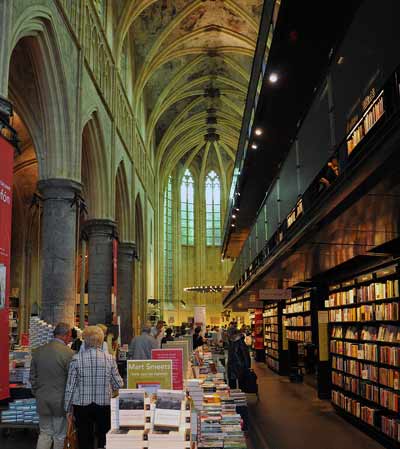中国有一个词叫“书香门第”,而在对待宗教相对宽容的荷兰,人们将一座历史悠久的教堂改建成了书店,使之成为一座“书香教堂”。在宽敞舒适的环境下读一本好书已是一件美事,再加上古雅的建筑和一丝宗教的味道,的确会让人产生一种置身天堂的感觉:好书店,天堂造。有机会能去马斯特里赫特的读者可一定要去观摩一番这座特色书店,才算不虚此行哦!

By Amrit Dhir
乐枫 选 曾真 译
|
What does a city do with an 800-year-old church with no congregation? Well, it could make like the Dutch and convert it into a temple of books. The old Dominican church in Maastricht was being used for bicycle storage not long ago, but thanks to a radical refurbishment by Dutch architects, it has been turned into what could possibly be the most beautiful bookshop of all time. Selexyz Dominicanen stands tall in the center of the city. As a 13th century gothic church, it offers its visitors a breathtaking high ceiling, a majestic nave, grand ornamentation, and an opportunity to worship: not at the great altar of God, but at the many altars of literature. Named as one of the “World’s 10 Best Bookshops” by the UK’s highly-regarded Guardian newspaper, the Selexyz Dominicanen has quickly become one of Maastricht’s tourist attractions. “After the Guardian article, this place has been a madhouse,” remarks William Remmers, General Department Head of the store. The bookstore fits almost snugly between Maastricht’s two dominant squares, the Markt and the Vrijthof. The renovation project was led by Selexyz, a large Dutch bookstore chain, in collaboration with the city council of Maastricht. Selexyz Dominicanen opened, to some medieval fanfare in November 2006. The Dominican friars began building their church in 1267, and it was consecrated in 1294. It endured through Maastricht’s often turbulent religious history for exactly five centuries until in 1794 post-revolutionary French forces annexed the city and expelled the Dominicans. The French used the church for religious purposes for a little over a decade and then converted it to a warehouse. “[The French] cavalry used it for their horses. Since then, it hasn’t really been used as a church,” notes Remmers. “It’s been multiple things: bicycle storage; a place to take exams for classes; there have been boxing matches here; reptile and amphibian shows; Christmas markets; it was even used as a second-hand book salespoint. It hasn’t been a church for over 200 years.” “In the last few years, religion [in the Netherlands] is declining, and a lot of churches are abandoned. People still think that they should serve a decent purpose. Of course, there are always some things you can do with a church and some things you can’t do,” Remmers reflects, “although I never heard people complaining about this being a bicycle storage or a place to party during Carnival.” Still, Selexyz Dominicanen represents the first project in the Netherlands to turn a church into a bookstore. And, in fact, this conversion has been beneficial to the cultural heritage of the site. The project team has conducted considerable restoration on the ceiling paintings. One indication of the great care with which the renovation was undertaken is perhaps the time the project took. Selexyz made its proposal in 2002, and worked with the city council of Maastricht and Entre Deux for the next four years before its opening in 2006. This care is furthermore illustrated by the architectural design of the site: “You have to consider a lot of things,” says Remmers. “First of all, it’s a church. Second of all, it’s also a monument. So you have to treat it with care. Everything you see here stands alone in the room. It doesn’t come attached to the walls. The cabinets where we hold our books all stand aside from the walls.” To maintain a sense of symmetrical balance in the space, lower tables of best sellers and latest releases have been added to either side, and of course a small cafe at the back for readers to relax and enjoy a hot drink. The bookstore has generated much buzz in the online world. Crossroads ’ photo feature on the opening of the store from the autumn of 2006 remains its most-viewed page. In addition, an Internet search reveals that there is also a good deal of interest from Japan. Asked about the Dutch reading habits, Remmers explains, “I think that the Dutch people like to read very much; they’re very versatile in their reading. The crime novels are very popular.” He adds, “Our English section sells very well. I think it has to do with a lot of people coming from Maastricht University who tend to read a little more in English.” The Dutch, the students, and the expatriates certainly constitute a unique and vibrant reading culture in Maastricht. Appropriately, they all now have an equally splendid place to congregate.
|
对于一座城市来说,一间有八百年历史却没有教众聚会的教堂能拿来干什么呢?嗯,可以模仿荷兰人,把它改建成一座图书的殿堂。马斯特里赫特市的多明我老教堂不久前还被用来存放自行车,但经过一群荷兰建筑师的彻底翻修之后,它摇身一变竟成了或许是有史以来最美的书店之一。 希莱克斯多明我书店高高耸立于市中心。这座建于13世纪的哥特式教堂为纷至沓来的参观者们展现的是高得惊人的天花板、宏伟的中殿和华美的装饰,并为人们提供了表达崇敬的机会:景仰的不是上帝的伟大圣坛,而是琳琅满目的文学著作。 英国久负盛名的《卫报》把希莱克斯多明我书店列入“全球十佳书店”,使之迅速成为马斯特里赫特市的旅游胜地之一。“《卫报》的那篇文章发表过后,这地方就人满为患了,”书店总务处主任威廉•雷默斯如是说。 马斯特里赫特市有两大广场——马克和瑞吉瑟夫广场,而书店就安然坐落于这两大广场之间。翻修工程是由荷兰的一家大型连锁书店希莱克斯主导完成的,并与马斯特里赫特市议会进行了合作。 2006年11月,希莱克斯多明我书店在一片中世纪的乐声中热热闹闹地开张了。多明我修道士们在1267年就开始修建这座教堂,并于1294年落成。它在马斯特里赫特市风起云涌的宗教历史中经历了整整五个世纪的洗礼,直到1794年,大革命后的法国军队吞并了这座城市,才将多明我修道士们驱逐出城。法国人在接下来的十多年里用这座教堂进行过一些宗教活动,之后就将其改为了仓库。 “(法国)骑兵将这里用作马厩,此后,也再没被人真正当作一个教堂来用,”雷默斯强调说,“这里有过很多用途:存放自行车、供班级考试、进行拳击比赛、举办爬行和两栖类动物展览、开办圣诞集市,甚至还曾经是二手书交易市场。它有两百多年的时间都没被当作教堂来使用。” “过去几年,(荷兰的)宗教江河日下,许多教堂都被废弃了。人们还是认为应该把教堂用来做一些庄重得体的事。当然,尽管我从没听大家抱怨说不该把教堂当作自行车库或狂欢节期间的聚会场所,但教堂的用途往往还是有一定限制的。” 雷默斯深思道。 尽管如此,希莱克斯多明我书店依然成为荷兰的第一项教堂变书店工程。而实际上,这一华丽变身也给教堂的文化传承带来了好处。项目组对天花板上的图案进行了大量的修复工作。修复工作中花费的大量心思也许可以从工程所用的时间当中略知一二。希莱克斯于2002年递交了方案,接下来又跟马斯特里赫特市议会和中间购物中心一起忙碌了四年,这才于2006年开张营业。 这种心思还进一步体现在书店的建筑设计上。“你得考虑到很多因素,”雷默斯说,“首先,这是一座教堂。其次,它还是一座纪念碑。因此,我们一定得小心对待。你在这儿看到的一切都是独立的,没有跟墙连在一起。我们放书的书柜全都独立于墙体。”为了保持空间中的对称平衡感,两侧都加设了稍矮的桌子来摆放畅销书和新书,当然,书店的后面还开有一个小咖啡馆,供读者放松和喝杯热饮。 书店在网上也引起了不少关注。《十字路口》杂志在2006年秋天书店开业时拍摄的照片成为其浏览量最大的页面。此外,互联网搜索显示,日本还有不少人对这家书店很感兴趣。 谈到荷兰人的阅读习惯,雷默斯解释道:“我觉得荷兰人都非常喜欢看书,而且看的书都很杂。探案小说极受欢迎。”他补充说,“我们的英语书也卖得很好。按我看,这是因为有不少人都来自马斯特里赫特大学,他们都倾向于多读些英文书籍。” 荷兰人、学生们和移居此地的人无疑形成了马斯特里赫特市独特而富有活力的阅读文化氛围。他们现在都恰如其分地找到了一处聚集在一起的绝妙地盘。 (来源:英语学习杂志)
|
|
Vocabulary: 1. congregation: 教众聚会,集会。 2. Dominican: (天主教修会)多明我会的。多明我会是由西班牙天主教修士圣多明我于1215年在法国图卢兹创建,又称布道兄弟会,1217年获教皇批准在罗马设总会。 3. fanfare: 喇叭、号角等的响亮吹奏声。 4. friar: 修道士。 5. annex: 侵占,吞并。 6. Crossroads: 《十字路口》杂志,是马斯特里赫特市本地的一本知名杂志。 |